Moderated Mediation or Mediated Moderation?
Differences and similarities
Arndt Regorz, Dipl. Kfm. & M.Sc. Psychologie, 07/02/2019
There are different ways to combine the concepts of mediation and moderation. Sometimes one speaks of mediated moderation, sometimes of moderated mediation (Muller, Judd, & Yzerbyt, 2005) and some simply speak of conditional indirect effects (Preacher, Rucker, & Hayes, 2007).
This tutorial is intended to bring some clarity to this confusion. It is essentially based on the standard texts by Muller et al. (2005) and Preacher et al. (2007).
Content
- Video
- Recap: Mediation and moderation
- Ideal-typical mediated moderation
- Ideal-typical moderated mediation
- Moderated moderation and moderated mediation in a broader sense
- Conditional indirect effects
- Relevance for the statistical analysis
- References
1. Video-Tutorial
(Note: When you click on this video you are using a service offered by YouTube.)
2. Recap: Mediation and moderation
Mediation is about how an effect from an independent variable to a dependent variable is mediated: The mediator is a third variable which is influenced by the independent variable and in turn influences the dependent variable.
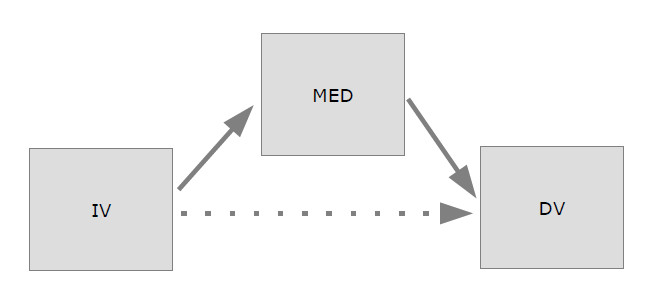
Moderation, on the other hand, is about what affects the strength (and direction, if any) of an effect. The moderator is a third variable that affects the strength of the effect of the independent variable on the dependent variable.
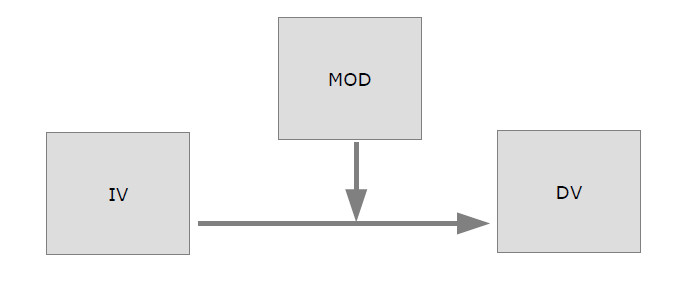
3. Ideal-typical mediated moderation
According to Muller et al. (2005), the ideal-typical mediated moderation is first of all a significant moderation. The strength of the relationship between an independent variable (IV) and a dependent variable (DV) thus depends on a moderator variable (MOD).
A mediated moderation then exists if this moderator effect is applied to an indirect path from the IV to the DV via a mediator (MED). So there is an indirect effect, the strength of which depends on the moderator and therefore the strength of the overall effect depends on the moderator.
This can be imagined as a road connection between two cities (I-city and D-city) at the rush hour, when the road has only a limited capacity. You can also take a detour via a third city (let's call it MED-city), but on this alternative route there is sometimes a construction site. The construction site here corresponds to the moderator, on it depends how much traffic can take the indirect way via the third city - and thus also how much traffic can flow during the rush hour in total. Of course, the construction site can be at different points, either between the I-city and the MED-city (= a-path of mediation), or between the MED-city and the D-city (= b-path of mediation), or at both sections.
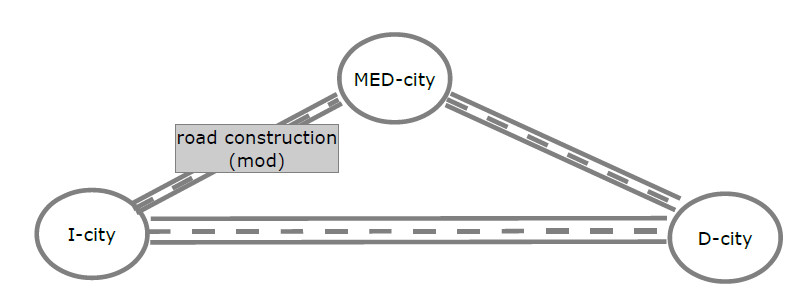
Mediated moderations and moderated mediations can be evaluated with the PROCESS macro from Hayes. Further information can be found on his PROCESS website (Hayes, n.d.) and in his book (Hayes, 2017).
A possible (not the only one) PROCESS model for an ideal-typical mediated moderation would be Model 7 (in PROCESS Version 3):
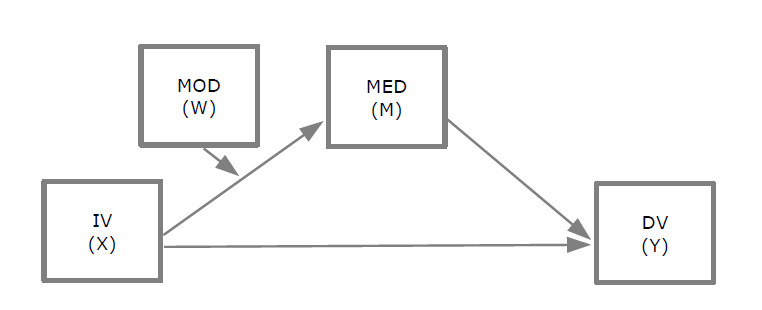
4. Ideal-typical moderated mediation
According to Muller et al (2005), ideal-typical moderated mediation has no overall moderation: the strength of the relationship between an independent variable (IV) and a dependent variable (DV) does not depend on a moderator variable (MOD).
However, in moderated mediation, the path between IV and DV depends on the moderator. Depending on the moderator, the relationship between a direct effect and an indirect effect shifts.
You can imagine this a bit like a railway connection between two cities (I-City and D-City). Normally the train runs the direct connection, but if there is an incident, a switch is turned over and instead the train runs a detour via a third city (MED city). The switch that controls whether the direct or indirect route is taken is the moderator here. And it only changes the way the train takes, but has no influence on the total number of passengers coming from I-City to D-City (= no moderation overall).
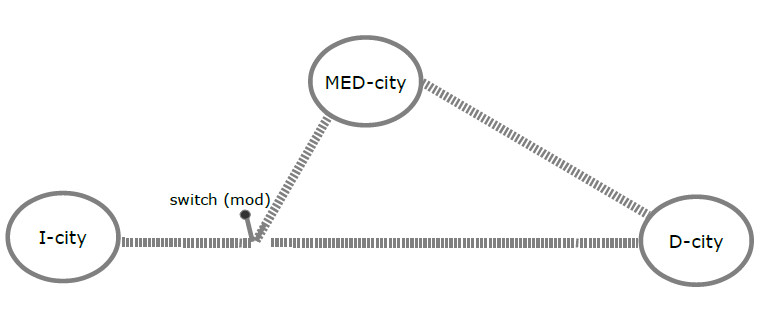
A possible (not the only one) PROCESS model for an ideal-typical moderated mediation would be Model 8 (in PROCESS Version 3):
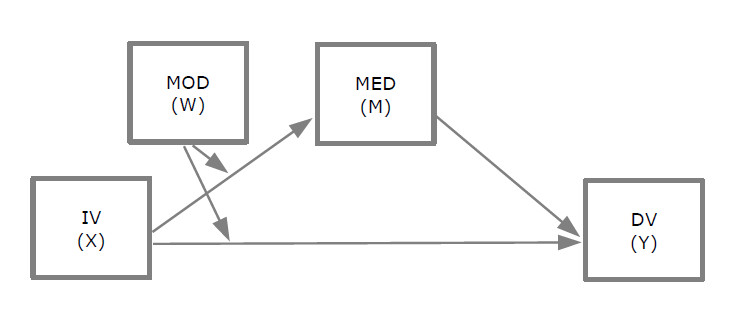
5. Moderated moderation and moderated mediation in a broader sense
Although this ideal-typical representation is theoretically quite convincing, it has a decisive disadvantage: In reality, there are often mixed forms that cannot be clearly assigned to one of the two ideal types.
Therefore, in addition to this ideal-typical representation, Muller et al. (2005) have also introduced definitions in a broader sense. The use of terms should depend on what the theoretical objective of the analysis is.
If there is a moderation as a whole and the main question is about the process generating this moderation effect, then in this sense there is a mediated moderation.
If, on the other hand, it is a matter of examining an indirect effect with regard to possible moderators, then it is moderated mediation. And this can be the case both without and with a moderating effect for the total effect.
One consequence of these definitions in the broader sense is that the two terms are no longer mutually exclusive. In this sense, a mediated moderation can always also be a moderated mediation, depending on the research question. Conversely, this does not necessarily apply, since mediated moderation still presupposes a total moderation effect, while moderated mediation is also possible without total moderation.
In this respect, mediated moderation in the broader sense is a subset of moderated mediation:
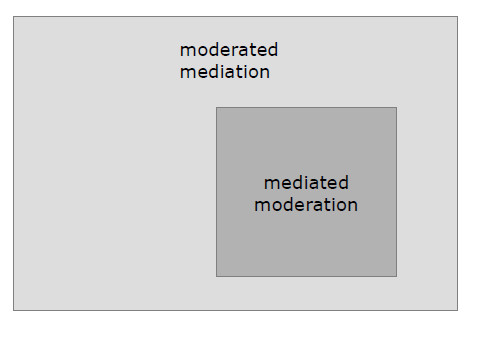
If one does not want to deal further with the definitions, using the term moderated mediation in the broader sense is a safe option.
6. Conditional indirect effects
Another way out of the question of how to call combinations of moderation and mediation is chosen by Preacher et al. (2007). They consistently use the term conditional indirect effects.
Their reason: "We believe this choice is warranted because all of the effects described above represent mediation effects that vary in strength conditional on the value of at least one moderator variable" (Preacher et al, 2007, p. 195).
This use of the term is the most convenient variant in this respect, because one then does not have to deal with the conceptual delimitation question any further.
7. Relevance for the statistical analysis
If you analyze your data in terms of a combination of moderation and mediation, then these conceptual questions actually have no effect.
You usually use PROCESS, find the model that best fits your theory, and evaluate it accordingly. Or you use SEM, e.g. for more complex models.
Only for the subsequent writing of your results would you have to commit yourself to one of the three terms mentioned above and, if necessary, justify it with the relevant source.
8. References
Hayes, A. F. (2017). Introduction to mediation, moderation, and conditional process analysis: A regression-based approach. New York, NY: Guilford Publications.
Hayes, A. F. (n.d.). PROCESS (Computer Software). Retrieved from https://www.processmacro.org/download.html
Muller, D., Judd, C. M., & Yzerbyt, V. Y. (2005). When moderation is mediated and mediation is moderated. Journal of personality and social psychology, 89, 852-863. doi:10.1037/0022-3514.89.6.852
Preacher, K. J., Rucker, D. D., & Hayes, A. F. (2007). Addressing moderated mediation hypotheses: Theory, methods, and prescriptions. Multivariate behavioral research, 42, 185-227. doi:10.1080/00273170701341316
Additional tutorials about moderated mediation
- Moderated Mediation with PROCESS model 7
- Moderated Mediation with PROCESS model 8
- Moderated Mediation with PROCESS model 14
- Moderated Mediation with PROCESS model 15
- Moderated Mediation with PROCESS models 21, 22, 28, 29